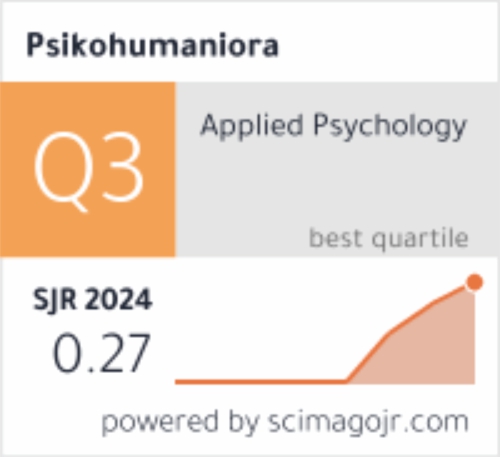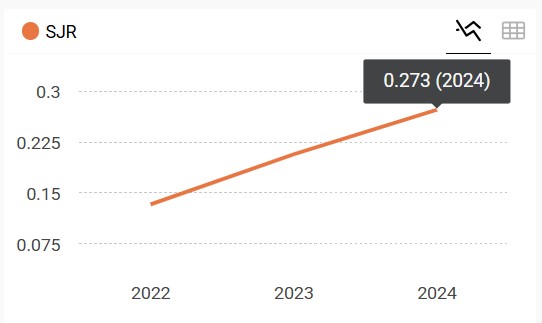Persepsi Dukungan Organisasi dan Komitmen Afektif Organisasi: Peran Mediasi Keterikatan Karyawan pada Karyawan Pertelevisian
DOI:
https://doi.org/10.21580/pjpp.v3i2.2790Keywords:
affective organization commitment, employee engagement, perceived organizational support, television broadcasting companyAbstract
Television broadcasting company has unique working condition with various challenges and demands to keep making innovations. This research aimed to study working conditions in television broadcasting companies in Indonesia using three variables, namely affective organization commitment (AOC), employee engagement (EE), and perceived organizational support (POS). The data were obtained by using 3 measurements, i.e. Affective Organization Commitment scale, Survey of perceived organizational support (SPOS), and Aon Hewitt Employee Engagement (AHEE). The respondents consisted of 139 employees of Indonesian television broadcasting companies which were obtained from convenience sampling with the criteria of being a permanent employee, having worked at least a year, and being 23-55 years old. Statistical techniques PROCESS that was developed by Hayes were applied to test the mediation role. The result showed that all variables were positively related and EE acted as partial mediator to correlation between POS and AOC,Downloads
References
Ahlowalia, S., Tiwary, D., & Jha, A. (2014). Employee engagement: A structured theoretical review. The International Journal of Business & Management, 2(6), 309.
Aon Hewitt. (2018). 2018 Trends in global employee engagement. Retrieved from https://de.statista. com/statistik/studie/id/52986/dokument/studie-zur-mitarbeitermotivation-weltweit-2018/
Azeem, S. M. (2010). Personality hardiness, job involvement and job burnout among teachers. International Journal of Vocational and Technical Education, 2(3), 36–40.
Beheshtifar, M., & Herat, B. H. (2013). To promote employees commitment via perceived organizational support. International Journal of Academic Research in Business and Social Sciences, 3(1), 306–314.
Caesens, G., Stinglhamber, F., & Ohana, M. (2016). Perceived organizational support and well-being: a weekly study. Journal of Managerial Psychology, 31(7), 1214–1230. https://doi.org/10.1108/JMP-01-2016-0002
Chamanifard, R., Nikpour, A., Chamanifard, S., & Nobarieidishe, S. (2015). Impact of organizational agility dimensions on employee’s organizational commitment in Foreign Exchange Offices of Tejarat Bank, Iran. Special Issue on New Dimensions in Economics, Accounting and Management, 4(1), 199–207.
Coffman, C., Gonzalez-Molina, G., & Gopal, A. (2002). Follow this path: How the world’s greatest organizations drive growth by unleashing human potential. New York, NY: Business Plus.
Cohen, A. (1993). Age and tenure in relation to organizational commitment: A meta analysis. Basic And Applied Social Psychology, 14(2), 143–159.
Cropanzano, R., & Mitchell, M. S. (2005). Social exchange theory: An interdisciplinary review. Journal of Management, 31(6), 874–900.
Dai, K., & Qin, X. (2016). Perceived organizational support and employee engagement: Based on the research of organizational identification and organizational justice. Open Journal of Social Sciences, 4(12), 46. https://doi.org/10.4236/jss.2016.412005
Eisenberger, R., Armeli, S., Rexwinkel, B., Lynch, P. D., & Rhoades, L. (2001). Reciprocation of perceived organizational support. Journal of Applied Psychology, 86(1), 42–51. https://doi.org/10.1037/0021-9010.86.1.42
Eisenberger, R., Fasolo, P., & Davis-LaMastro, V. (1990). Perceived organizational support and employee diligence, commitment, and innovation. Journal of Applied Psychology, 75(1), 51. https://doi.org/10.1037/0021-9010.75.1.51
Eisenberger, R., Huntington, R., Hutchison, S., & Sowa, D. (1986). Perceived organizational support. Journal of Applied Psychology, 71(3), 500–507.
Federman, B. (2009). Employee engagement: A roadmap for creating profits, optimizing performance, and increasing loyalty. San Francisco: John Wiley & Sons Inc.
Forastero, A., Sjabadhyni, B., & Mustika, M. D. (2018). What millennials want: How to optimize their work. Psikohumaniora: Jurnal Penelitian Psikologi, 3(1), 1–16. https://doi.org/10.21580/pjpp.v3i1.2489
Gaertner, K. N., & Nollen, S. D. (1989). Career experiences, perceptions of employment practices, and psychological commitment to the organization. Human Relations, 42(11), 975–991.
Gelderen, B. R. van, & Bik, L. W. (2016). Affective organizational commitment, work engagement and service performance among police officers. Policing: An International Journal of Police Strategies & Management, 39(1), 206–221. https://doi.org/10.1108/PIJPSM-10-2015-0123
Gigliotti, R., Vardaman, J., Marshall, D. R., & Gonzalez, K. (2018). The role of perceived organizational support in individual change readiness. Journal of Change Management, 1–15. https://doi.org/10.1080/14697017.2018.1459784
Gokul, A., Sridevi, G., & Srinivasan, P. T. (2012). The relationship between perceived organizational support, work engagement and affective commitment. AMET International Journal of Management, 4(July-Dec). Retrieved from http://www.ametjournal.com/attachment/ametjournal-4/Dev-Article-4-Gokul.pdf
Gravetter, F. J., & Forzano, L.-A. B. (2012). Research methods for the behavioral sciences (4th ed.). Belmont, CA: Wadsworth Gengage Learning.
Hayes, A. F. (2018). Introduction to mediation, moderation, and conditional process analysis: A regression-based approach (2nd ed.). New York: Guilford Publications.
Hewitt Associates. (2004). Employee engagement higher at double-digit growth companies: Double-digit growth and engagement (Research brief). Illionis. Retrieved from http://www.connectthedotsconsulting.com/documents/Engagement/EE Engagement at DD Growth Companies 2012.pdf
Jena, L. K., Bhattacharyya, P., & Pradhan, S. (2017). Employee engagement and affective organizational commitment: Mediating role of employee voice among Indian service sector employees. Vision: The Journal of Business Perspective, 21(4), 356–366. https://doi.org/10.1177/ 0972262917733170
Kahn, W. A. (1990). Psychological conditions of personal engagement and disengagement at work. Academy of Management Journal, 33(4), 692–724. https://doi.org/10.2307/256287
Kobasa, S. C., Maddi, S. R., & Kahn, S. (1982). Hardiness and health: A prospective study. Journal of Personality and Social Psychology, 42(1), 168–177. https://doi.org/10.1037/0022-3514.42.1.168
Lynch, P. D., Eisenberger, R., & Armeli, S. (1999). Perceived organizational support: Inferior versus superior performance by wary employees. Journal of Applied Psychology, 84(4), 467–483. https://doi.org/10.1037/0021-9010.84.4.467
Mangundjaya, W. L. H. (2014). The role of employee engagement on the commitment to change (During large-scale organizational change in Indonesia). IJMT: International Journal of Multidisciplinary Thought, 4(1), 375–384.
Mangundjaya, W. L. H., Utoyo, D. B., & Wulandari, P. (2015). The role of leadership and employee’s condition on reaction to organizational change. Procedia-Social and Behavioral Sciences, 172, 471–478.
Maslach, C., Schaufeli, W. B., & Leiter, M. P. (2001). Job burnout. Annual Review of Psychology, 52(1), 397–422. https://doi.org/10.1146/annurev.psych.52.1.397
Mercurio, Z. A. (2015). Affective commitment as a core essence of organizational commitment: An integrative literature review. Human Resource Development Review, 14(4), 389–414. https://doi.org/10.1177/1534484315603612
Meyer, J. P., & Allen, N. J. (1987). Organizational commitment: Toward a three-component model. London: Department of Psychology, University of Western Ontario.
Meyer, J. P., & Allen, N. J. (1990). The measurement and antecedents of affective, continuance and normative commitment to the organization. Journal of Occupational Psychology, 63(1), 1–18. https://doi.org/10.1111/j.2044-8325.1990.tb00506.x
Meyer, J. P., & Allen, N. J. (1991). A three-component conceptualization of organizational commitment. Human Resource Management Review, 1(1), 61–89. https://doi.org/10.1016/1053-4822(91) 90011-Z
Meyer, J. P., & Allen, N. J. (1997). Commitment in the workplace: Theory, research, and application. Thousand Oaks, CA: SAGE Publications, Inc. https://doi.org/10.4135/9781452231556
Meyer, J. P., Stanley, D. J., Herscovitch, L., & Topolnytsky, L. (2002). Affective, continuance, and normative commitment to the organization: A meta-analysis of antecedents, correlates, and consequences. Journal of Vocational Behavior, 61(1), 20–52. https://doi.org/10.1006/jvbe.2001.1842
Nugroho, Y., Putri, D. A., & Laksmi, S. (2012). Mapping the landscape of the media industry in contemporary Indonesia. Jakarta: Centre for Innovation Policy and Governance & Ford Foundation. Retrieved from https://www.escholar.manchester.ac.uk/api/datastream?publicationPid=uk-ac-man-scw:168565&datastreamId=FULL-TEXT.PDF
O’Donohue, W., & Nelson, L. (2014). Alienation: An old concept with contemporary relevance for human resource management. International Journal of Organizational Analysis, 22(3), 301–316. https://doi.org/10.1108/ijoa-01-2012-0541
Ogilvie, J. R. (1986). The role of human resource management practices in predicting organizational commitment. Group & Organization Studies, 11(4), 335–359. https://doi.org/10.1177/0364108286114003
Pitt-Catsouphes, M., Smyer, M. A., Matz-costa, C., & Kane, K. (2007). The national study report: Phase II of the national study of business strategy and workforce development (Vol. 4). Boston: The Center on Aging & Work - Boston College.
Podsakoff, P. M., MacKenzie, S. B., Lee, J. Y., & Podsakoff, N. P. (2003). Common method biases in behavioral research: A critical review of the literature and recommended remedies. Journal of Applied Psychology, 88(5), 879–903. https://doi.org/10.1037/0021-9010.88.5.879
Posthuma, R. A., Campion, M. C., Masimova, M., & Campion, M. A. (2013). A high performance work practices taxonomy: Integrating the literature and directing future research. Journal of Management, 39(5), 1184–1220. https://doi.org/10.1177/0149206313478184
Pourghaz, A., Tamini, B. K., & Karamad, A. (2011). Do demographic characteristics make a difference to job satisfaction, organizational commitment and burnout among travel agency drivers? A case study in Iran. Journal of Basic and Applied Scientific Research, 1(8), 916–923.
Rhoades, L., & Eisenberger, R. (2002). Perceived organizational support: A review of the literature. Journal of Applied Psychology, 87(4), 698–714. https://doi.org/10.1037/0021-9010.87.4.698
Rhoades, L., Eisenberger, R., & Armeli, S. (2001). Affective commitment to the organization: The contribution of perceived organizational support. Journal of Applied Psychology, 86(5), 825. https://doi.org/10.1037//0021-9010.86.5.825
Robinson, D., Perryman, S., & Hayday, S. (2004). The drivers of employee engagement. Brighton, UK: Institute For Employment Studies. Retrieved from www.employment-studies.co.uk/pubs/report.php?id=447
Santoso, A. R. (2018). Workshop coaching atasan untuk meningkatkan persepsi pegawai terhadap dukungan atasan dan komitmen afektif untuk berubah. Universitas Indonesia.
Sanusi. (2013). 200 karyawan Trans TV dikabarkan resign, apa jawaban Trans Corp? Retrieved from http://www.tribunnews.com/bisnis/2013/06/03/200-karyawan-trans-tv-dikabarkan-resign-apa-jawaban-trans-corp
Schmidt, K.-H. (2007). Organizational commitment: A further moderator in the relationship between work stress and strain? International Journal of Stress Management, 14(1), 26. https://doi.org/10.1037/1072-5245.14.1.26
Seniati, L. (2006). Pengaruh masa kerja, trait kepribadian, kepuasan kerja, dan iklim psikologis terhadap komitmen dosen pada Universitas Indonesia. Makara: Human Behavior Studies in Asia, 10(2). https://doi.org/10.7454/MSSH
Tepper, B. J., & Taylor, E. C. (2003). Relationships among supervisors’ and subordinates’ procedural justice perceptions and organizational citizenship behaviors. Academy of Management Journal, 46(1), 97–105. https://doi.org/10.2307/30040679
Viswesvaran, C., Sanchez, J. I., & Fisher, J. (1999). The role of social support in the process of work stress: A meta-analysis. Journal of Vocational Behavior, 54(2), 314–334. https://doi.org/10.1006/jvbe.1998.1661
Wardhana, A. K. (2018). Stress kerja: Penyebab, dampak dan solusinya (Studi kasus pada karyawan NET Yogyakarta). Uniersitas Islam Indonesia, Yogyakarta.
Wayne, S. J., Shore, L. M., & Liden, R. C. (1997). Perceived organizational support and leader-member exchange: A social exchange persp
Downloads
Published
How to Cite
Issue
Section
License
The copyright of the accepted article shall be assigned to the publisher of the journal. The intended copyright includes the right to publish the article in various forms (including reprints). The journal maintains the publishing rights to published articles.
In line with the license, authors and any users (readers and other researchers) are allowed to share and adapt the material only for non-commercial purposes. In addition, the material must be given appropriate credit, provided with a link to the license, and indicated if changes were made. If authors remix, transform, or build upon the material, authors must distribute their contributions under the same license as the original.




